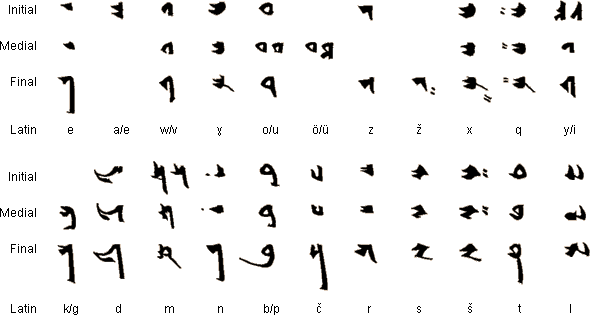lingvo.wikisort.org - Alphabet
The Old Uyghur alphabet was used for writing the Old Uyghur, a variety of Old Turkic spoken in Turpan and Gansu that is the ancestor of the modern Western Yugur language.[1] The term "Old Uyghur" used for this alphabet is misleading because Qocho, the Uyghur (Yugur) kingdom created in 843, originally used the Old Turkic alphabet. The Uyghur adopted this "Old Uyghur" script from local inhabitants when they migrated into Turfan after 840.[2] It was an adaptation of the Aramaic alphabet used for texts with Buddhist, Manichaean and Christian content for 700–800 years in Turpan. The last known manuscripts are dated to the 18th century. This was the prototype for the Mongolian and Manchu alphabets. The Old Uyghur alphabet was brought to Mongolia by Tata-tonga.
| Old Uyghur alphabet | |
|---|---|
| Script type | Abjad/Alphabet
|
Time period | ca.700s–1800s |
| Direction | horizontal and vertical writing in East Asian scripts, top-to-bottom Vertical (left-to-right); Horizontal (right-to-left), used in modern printing, especially in multi-lingual publications |
| Languages | Old Uyghur, Western Yugur |
| Related scripts | |
Parent systems | Egyptian hieroglyphs
|
Child systems | Traditional Mongolian alphabet |
| ISO 15924 | |
| ISO 15924 | Ougr (143), Old Uyghur |
| Unicode | |
Unicode alias | Old Uyghur |
Unicode range | U+10F70–U+10FAF |
The Old Uyghur script was used between the 8th and 17th centuries primarily in the Tarim Basin of Central Asia, located in present-day Xinjiang Uygur Autonomous Region, China. It is a cursive-joining alphabet with features of an abjad and is written vertically. The script flourished through the 15th century in Central Asia and parts of Iran, but it was eventually replaced by the Arabic script in the 16th century. Its usage was continued in Gansu through the 17th century.[3]
Like the Sogdian alphabet (technically, an abjad), the Old Uyghur tended to use matres lectionis for the long vowels as well as for the short ones. The practice of leaving short vowels unrepresented was almost completely abandoned.[4] Thus, while ultimately deriving from a Semitic abjad, the Old Uyghur alphabet can be said to have been largely "alphabetized".[5]

Gallery
- Yuan dynasty Buddhist inscription written in Old Uyghur on the west wall of the Cloud Platform at Juyong Pass
- Yuan dynasty Buddhist inscription written in Old Uyghur on the east wall of the Cloud Platform at Juyong Pass
- Slave contract
 Contract on taxation
Contract on taxation Ming era text from volume with accompanying Chinese translation
Ming era text from volume with accompanying Chinese translation- Yuan era epitaph
- Mehmed the Conqueror's Fetihname (Declaration of conquest) after the Battle of Otlukbeli
- Jarlig of Temür Qutlugh
Unicode
The Old Uyghur alphabet was added to the Unicode Standard in September, 2021 with the release of version 14.0.
The Unicode block for Old Uyghur is U+10F70–U+10FAF:
| Old Uyghur[1][2] Official Unicode Consortium code chart (PDF) | ||||||||||||||||
| 0 | 1 | 2 | 3 | 4 | 5 | 6 | 7 | 8 | 9 | A | B | C | D | E | F | |
| U+10F7x | 𐽰 | 𐽱 | 𐽲 | 𐽳 | 𐽴 | 𐽵 | 𐽶 | 𐽷 | 𐽸 | 𐽹 | 𐽺 | 𐽻 | 𐽼 | 𐽽 | 𐽾 | 𐽿 |
| U+10F8x | 𐾀 | 𐾁 | 𐾂 | 𐾃 | 𐾄 | 𐾅 | 𐾆 | 𐾇 | 𐾈 | 𐾉 | ||||||
| U+10F9x | ||||||||||||||||
| U+10FAx | ||||||||||||||||
| Notes | ||||||||||||||||
See also
References
Citations
- Osman, Omarjan. (2013). L2/13-071 Proposal to Encode the Uyghur Script.
- Sinor, D. (1998), "Chapter 13 - Language situation and scripts", in Asimov, M.S.; Bosworth, C.E. (eds.), History of Civilisations of Central Asia, vol. 4 part II, UNESCO Publishing, p. 333, ISBN 81-208-1596-3
- Pandey, Anshuman (2020-12-18). "Final proposal to encode Old Uyghur in Unicode" (PDF). L2/20-191. Retrieved 2021-02-11.
- Clauson, Gerard. 2002. Studies in Turkic and Mongolic linguistics. P.110-111.
- Houston, Stephen D. 2004. The first writing: script invention as history and process (p.59).
Sources
- Gorelova, Liliya M. (2002). Manchu Grammar. Brill. ISBN 978-90-04-12307-6.
External links
- Latin to Old Uyghur transliteration
- Old Uyghur Alphabet on Omniglot
- Old Uyghur alphabet and Orkhon Turkic alphabet
На других языках
- [en] Old Uyghur alphabet
[ru] Староуйгурское письмо
Староуйгурское письмо (уйгурское вертикальное письмо, также просто уйгурское) — алфавит, который уйгуры использовали для записи древнеуйгурского языка с VIII по XVI век н. э.Другой контент может иметь иную лицензию. Перед использованием материалов сайта WikiSort.org внимательно изучите правила лицензирования конкретных элементов наполнения сайта.
WikiSort.org - проект по пересортировке и дополнению контента Википедии







